Coaching Basketball - Reducing Turnovers
By Dr. James Gels, From the Coach’s Clipboard Basketball Playbook"Helping coaches coach better..."
Disclosure: This page contains affiliate links, which means that Coach's Clipboard receives a small commission (at no cost to you) if you make a purchase using these links.
During basketball season you'll frequently see a headline like, "Tech Turnovers Cost Game" or "Turnovers Costly in Raiders Loss". When TV analysts discuss key stats, they often bring up not only turnovers, but "points off turnovers". And point guards are graded on their "assists to turnover ratio". So too many turnovers can be a killer.
First a definition... a turnover occurs whenever the team with the ball loses possession of the ball to the opponent as the result of a steal, a bad pass, an offensive violation (e.g. traveling and others), stepping out-of-bounds, or an offensive foul.
Your offense should strive to get a good shot every possession. A turnover results in a lost, wasted possession as you get no shot at all. If the turnover occurs near half-court or in the back-court, it may result in an easy lay-up for the opponent ("points off turnovers") - in effect a four-point turn-around.
Good teams value every possession and look for a good shot every trip up the court. We had a 14-point lead last night in the 3rd quarter, and then after six consecutive turnovers, it's a close game. Turnovers kill your momentum and your offense.
But don't despair. It's a common problem. All coaches and many teams go through it. Players want to use their athleticism and "play the game", without worrying about losing the ball. As a result, oftentimes a player is in too much of a hurry, out of control, and the turnover occurs. Coaches have to do what they can to reign them in and teach them to value each possession. We want players to be aggressive and attack the defense, but there is a fine line between playing "on the edge" (under control) and "out of control".
I have categorized turnovers in two ways, based on (1) an error in a fundamental skill, and (2) the game situation in which the turnover occurs.
Errors in Fundamental Skills
- Ball-Handling Turnovers
- Passing Turnovers
- Catching-Receiving Turnovers
- Traveling Violation Turnovers
- Offensive Fouls
- Other Violations
Game Situations/Settings
- Turnovers when Confronted by a Press Defense
- Turnovers in Transition
- Turnovers in Your Half-Court Offense
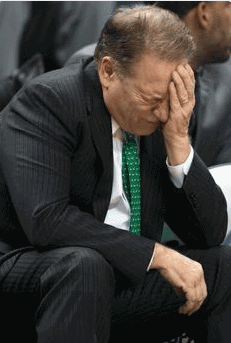
Ball-Handling Turnovers
Your players must be skilled in ball handling and dribbling. If not, do ball-handling and dribbling drills every practice. Youth teams should be spending some time with this every practice. The double-dribble violation is common in youth basketball.Point-guards and perimeter players must learn not to "carry" the ball when dribbling. They must avoid getting the hand under the ball.
Point-guards must be tough and protect the ball. It's a bad turnover when your point guard "gets stripped" and has the ball stolen at half-court, and the opponent dribbles down for a lay-up.
When dribbling the ball into the forecourt, the point guard should protect the ball behind him/her and "go somewhere" with the ball. Point-guards that just stand out front and pound (dribble) the ball without going somewhere are a turnover waiting to happen, especially if he/she makes cross-over dribbles right in front of a defender who has quick hands.
If your point guard is having problems with a quick defender when bringing the ball into the forecourt, instruct him/her to pass quickly to the off-guard, and then get the pass back and run the offense. Why challenge the defender when you can simply pass to an open teammate? Optionally, you could screen for the point guard to help relieve the pressure.
Dribbling into traffic, attempting to dribble between two well-placed defenders is a common error that leads to a turnover.
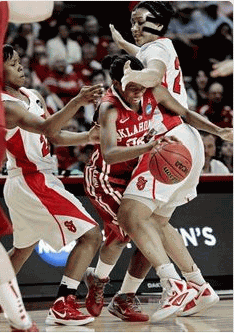
Passing/Receiving Turnovers
Many turnovers are the result of poor passing, or simply not catching the ball.What is a good pass?
A good pass is one that is caught in a spot on the court where something good can happen. A pass might be "on target" but if it's too hard for the receiver to catch, it's not a good pass. Or if the pass is caught by the receiver, but he/she is surrounded by defenders, it's not a good pass.
Passes must be on-target. Passers must "see the defense", make the sure pass. Keep it simple, and use pass-fakes. A good passer does not hurry, and keeps grounded, avoiding the jump-pass. A good passer might use the dribble to create an open passing lane, whether a pass to the low post or on a dribble-drive and kick-out to a perimeter player.
If the pass is not caught, it's almost always a turnover. Receivers should catch the ball with two-hands when possible (sometimes the one-handed catch is the best or only option). Use a hand target and get to the ball (move toward the ball with hands ready). Catch the ball in triple-threat position.
Try the "Bennett drill" to improve your half-court passing and help reduce turnovers. See Tips for Better Passing.
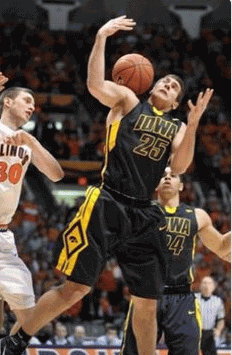
Traveling Violation Turnovers
- Perimeter players - triple-threat position
Perimeter players must get in the habit of catching the ball in triple-threat position, and establishing a pivot foot. Players must be drilled on not picking up the pivot foot until the dribble has started. Teach a good shot-fake followed by a quick dribble move, but make sure the pivot foot doesn't come up too soon. See Outside, Guard Moves. - Post players
Post play is all about footwork, using the pivot foot without traveling or shuffling the feet. Post players must be adept in post-moves, but also must recognize not to force things and pass back out to the perimeter. A forced, bad shot or a blocked shot, although technically not a turnover, really is just like a turnover. See How to Become a Good Post Player. - Use the jump-stop
Teach players to use the jump-stop not only when catching the ball, but also at the end of a dribble. This helps the player to maintain control(show video).
Offensive Fouls
Offensive fouls are turnovers too, as they result in the loss of possession.- Avoid the charging foul
Avoid the charging foul with good court vision, seeing that the defense is already set, and playing under control. Here again, the jump-stop is very helpful at the end of a dribble-drive.
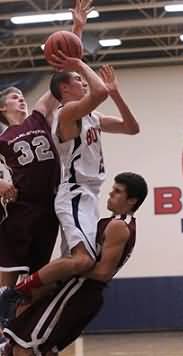
- Post player offensive foul
Good post play involves good footwork and using post-moves and shot-fakes to beat the defender. If you lower your shoulder and bump the defender, you will probably get the charging foul. Or, if you hook the defender with your off arm, it's usually an offensive foul. - Illegal screen
The screener must be stationary with feet set and arms in - no pushing!
Other Violations
Without going into details, here is a list of additional offensive violations that result in turnovers.- 3-seconds violation (in the lane too long)
- Shot-clock violation (if a shot-clock is being used)
- Free-throw lane violation (in the lane too soon on a free-throw)
- 10-seconds back-court violation (delay in getting across the half-court line)
- 5-seconds closely-guarded violation (guards who dribble too much)
- Over-and-back violation (ball in forecourt lost into the back-court)
- Stepping out-of-bounds (player with the ball)
- Passing inbounds violations (5-second call, stepping across the line, illegal moving)
Game Situations/Settings
Turnovers when Confronted by a Press Defense
You must have a good press offense(s) to help your players handle full-court, 3/4-court or 1/2-court press defenses. See Press Offenses. When preparing for an opponent, practice your press offense. Often you will have to make game-time adjustments against pressing teams.Teach players (1) to be calm, (2) attack the defense, and (3) the three "looks" - look and see the floor, look before passing, and look before dribbling. To calm your players, you must be calm in your coaching and instruction.
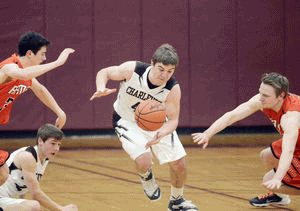
Turnovers in Transition
Turnovers can occur when transitioning quickly from defense to offense.Off the defensive rebound.
When the defensive rebound is secured, the point guard must get to an outlet spot or come back to the rebounder for an open passing lane. Rebounders must be strong with the ball, get triple-threat and pivot to find a receiver, or make a one-bounce power dribble just to get clear of the defenders and create a passing lane.
After a steal or interception.
How often do you see a player come up with a steal, a loose ball or an interception only to have his next pass intercepted right back by the opponent? It happens a lot... I call it the "steal->turnover".
Here's a tip. We teach our players that whenever they get a steal or interception, to avoid passing into the middle of the court, because that's where the defense is sprinting back - down the middle of the court. Instead, after securing a steal or interception, get under control, see the court, and advance the ball up the sideline. The exception of course is an obvious break-away lay-up situation.
Recognize when to abort the break.
Score off the fast break or secondary break whenever you can, but when the defense is set, pull the ball back out and run your offense. Do not force bad passes and bad shots in transition. Run your offense!
Turnovers in Your Half-Court Offense
Much of what has already been discussed above under passing and catching, ball-handling, etc applies to turnovers in the half-court. But to add some important pointers... maintain good spacing, use back-cuts (especially against pressure defenses), pass and cut, rotate on the perimeter, players must not stand around... keep moving! It's easy to defend a team that doesn't move.Avoid the sideline and baseline... many turnovers occur within three feet of either the baseline or the sideline. Teach players not to stop the dribble along the baseline. If stopped on the baseline, keep the dribble going and dribble (or pass) back out. Wing players should learn to attack the top (elbow) seam, which affords more options than the baseline dribble.
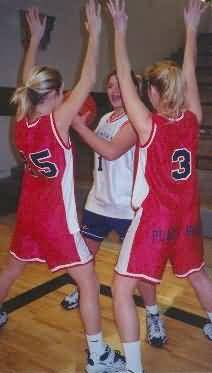
If wing players are being trapped, make sure you have a player in the high-post (free-throw line area) and one at ball-side corner for passing options, as well as the point guard helping out on top. Once the ball is passed out of the trap, immediately reverse the ball to the opposite side and you should have an advantage.
A savvy point guard will pass-fake to one wing, getting the defenders to jump, and then pass instead to the opposite wing or high-post. This disrupts the timing of the defenders wanting to rush out and trap the wing.
Against the 2-3 zone, teach your perimeter players to drive the seams, but pull-up for a jump-shot near or just inside the elbow. Don't get too deep inside where the three tall inside defenders are waiting.
Bad shots... forced, off-balance, "crappy" shots, while technically not a turnover, are just as bad, resulting in a poor shot for your team on that possession. Ingrain your players to value each possession. Be patient and don't hurry. Execute. Get a good shot. Rebound.
Finally, remember that in basketball there is no such thing as a perfect game, and you can never completely eliminate turnovers. Coaches must remain patient and encouraging, and teach our players how to play hard, but under control. As Coach John Wooden once said, "A good garden may have some weeds." - just not too many!